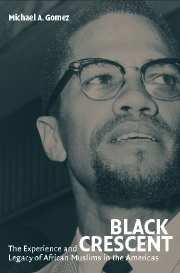Book contents
- Frontmatter
- Contents
- Acknowledgments
- Prologue
- PART ONE
- 1 Ladinos, Gelofes, and Mandingas
- 2 Caribbean Crescent
- 3 Brazilian Sambas
- 4 Muslims in New York
- 5 Founding Mothers and Fathers of a Different Sort: African Muslims in the Early North American South
- Interlude: Into a Glass Darkly – Elisive Communities
- PART TWO
- Epilogue
- Index
1 - Ladinos, Gelofes, and Mandingas
Published online by Cambridge University Press: 05 June 2012
- Frontmatter
- Contents
- Acknowledgments
- Prologue
- PART ONE
- 1 Ladinos, Gelofes, and Mandingas
- 2 Caribbean Crescent
- 3 Brazilian Sambas
- 4 Muslims in New York
- 5 Founding Mothers and Fathers of a Different Sort: African Muslims in the Early North American South
- Interlude: Into a Glass Darkly – Elisive Communities
- PART TWO
- Epilogue
- Index
Summary
On the lush island of Hispaniola in 1522, Admiral Diego Columbus, governor and son of the explorer, received a most unusual gift early Christmas morning. At the sound of the second cockcrow, some twenty enslaved persons, heretofore proscribed within what was a sizeable ingenio, or sugar mill and its environs, lay aside their fears and set upon a path of alteration. Intent on spreading sedition throughout the island, the insurrectionists moved to mobilize an equal number of coconspirators on neighboring establishments. Machetes in hand, they literally dismembered plantation personnel and livestock as they proceeded, initiating a “wild and bloody expedition under dawn's early light.” In their wake lay torched houses and fields, while “here and there in the open ground lie the decapitated bodies of unfortunate whites who [the insurgents] were able to catch off-guard.” On December 28 they reached the cattle ranch of Melchoir de Castro, some thirty miles from the island's capital of Santo Domingo, upon which they may have been planning an assault. By then, however, they no longer enjoyed the element of surprise; a mixed force of Europeans and indigenous persons under Melchoir de Castro's leadership, both militia and volunteers, attacked the desperate band of Africans, effectively ending the revolt. Those not immediately killed took to the hills, only to be captured within a week.
- Type
- Chapter
- Information
- Black CrescentThe Experience and Legacy of African Muslims in the Americas, pp. 3 - 46Publisher: Cambridge University PressPrint publication year: 2005



